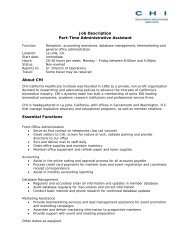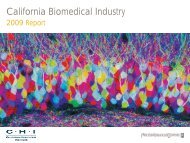California Biomedical Industry - California Healthcare Institute
California Biomedical Industry - California Healthcare Institute
California Biomedical Industry - California Healthcare Institute
You also want an ePaper? Increase the reach of your titles
YUMPU automatically turns print PDFs into web optimized ePapers that Google loves.
Special sectionWireless technology promises to rein in costswhile improving healthcareEric J. Topol, M.D. is the director ofthe Scripps Translational Science<strong>Institute</strong>, a National <strong>Institute</strong>s ofHealth funded program of the Clinicaland Translational Science Award(CTSA) Consortium focused onadvancing individualized medicine.He is the chief academic officer ofScripps Health, a senior consultantcardiologist practitioner at ScrippsClinic, and professor of translationalgenomics at The Scripps Research<strong>Institute</strong>.Digital devices, such as smart phonesand the iPad, have changed the worldin a single generation. The technologyhas rearranged human routines, popculture, marketing and politics.Those transformations, however, arelikely to be dwarfed by the imminentadvances wireless technologies will offerto healthcare.Eric J. Topol, M.D., vice chairman ofthe board and chief innovation officer ofthe West Wireless Health <strong>Institute</strong>, said,“We will all be connected to cell phonessoon.” Indeed, more than 5 billion cellphones already are in use worldwide,and half of all Americans are expected tohave smart phones by the end of 2011.As mobile devices have grown smallerand smarter, so has technology formonitoring vital signs. Sensors on thewrist can collect blood pressure, heartrate, oxygen concentration in the blood,breathing rate, body temperatureand more. Combining the sensors’capabilities and people’s comfort withand access to cell phones, Topol said,“has huge implications for healthcaredelivery.”Topol illustrated the potentialby explaining that smart phoneapplications can be developed tomonitor any physiologic metric. Themeasurements can be taken remotely,making it possible for patients toadhere to their regular work and familyschedules and for healthcare providersto assist them from miles away.A more continuous gathering of dataalso better indicates the state of one’shealth than does the “snapshot”approach of collecting key measuresonly during office visits. That isespecially true for cardiovascularpatients, Topol said, where the trueindicator of heart attack or stroke riskis not high blood pressure but, rather,swings in blood pressure from high tolow. Frequent or continuous monitoringmay pick up the signs of an imminentincident — such as a heart attack —triggering the patient to take immediateaction to prevent it.Cardiovascular disease is one indicationfor which <strong>California</strong>-developed wirelesshealth products already are available(see side bar on page 52).Diabetes is another condition in whichwireless technologies could play a keyrole. Nearly 20 million Americans areat risk of developing the disease and 30million already have. Worldwide, 300million people have diabetes. Topol,who has monitored his own glucose outof curiosity, said that managing diabetesis a highly complex and delicateendeavor.“Most diabetics don’t have a cluewhat’s stressing their pancreases,” hesaid. With new wireless devices, theywould “have the technology to helpthem pinpoint what’s knocked them offbalance.”The overarching objective is to preventdisease, Topol said. Using a continuousglucose monitoring “app,” individualsat risk of developing Type 2 diabetescould more easily determine their bestfood, exercise and lifestyle choicesfor attaining optimal blood sugarresults — as measured by their device.By incorporating their findings intotheir daily lives, they could prevent thedisease from ever occurring.By empowering patients with real-timeinformation and immediate feedbackto help them manage their disease,wireless technology could make asignificant and positive difference inpatients’ and their caregivers’ quality oflife. At the same time, the cost-savingspotential is enormous.“The U.S. spends $2.5 trillion dollarsin healthcare annually,” Topol said.“And one-third of the costs are diabetesrelated.” With the CDC estimating thatup to one in three Americans will havediabetes by 2050, wireless technologythat lessens the costs could not comesoon enough.Topol said that social media could beharnessed to create competitivenessamong community members to adoptmore healthful behaviors. As evidence,Nike sells a wristband for runnersthat tracks such data as distance,pace, time and calories burned duringa run. That data can be uploaded tonikeplus.com, where users can charttheir personal progress and shareit with others in the Nike+ onlinecommunity. The technology also can beused to publish results on individuals’Facebook, Twitter or other social mediaaccounts. Having friends — actualor cyber — to show off for or to offersupport increases one’s commitment tohealthful behaviors.“<strong>California</strong> is the center of socialmedia,” he added, “which is going to bebigger for healthcare than anyone hasenvisioned.” He said that at the same50 | <strong>California</strong> <strong>Biomedical</strong> <strong>Industry</strong> 2011 Report






